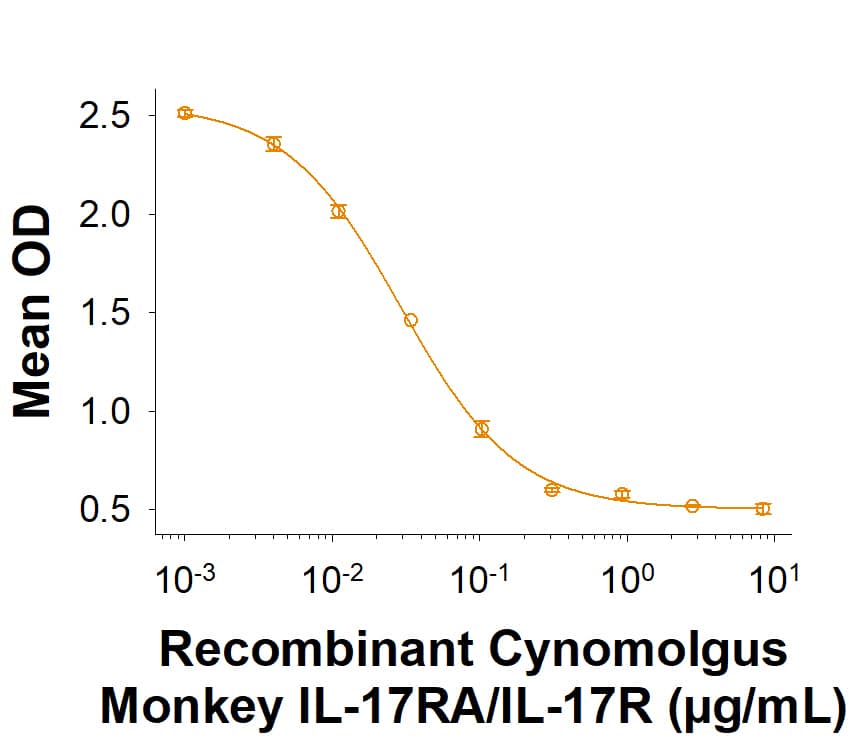Recombinant Cynomolgus Monkey IL-17RA/IL-17R His Protein, CF
R&D Systems, part of Bio-Techne | Catalog # 11342-IR
His-tag

Key Product Details
Product Specifications
Source
Chinese Hamster Ovary cell line, CHO-derived cynomolgus monkey IL-17RA/IL-17R protein
Leu33-Trp320, with a C-terminal 6-His tag
Leu33-Trp320, with a C-terminal 6-His tag
Purity
>95%, by SDS-PAGE visualized with Silver Staining and quantitative densitometry by Coomassie® Blue Staining.
Endotoxin Level
<0.10 EU per 1 μg of the protein by the LAL method.
N-terminal Sequence Analysis
Leu33
Predicted Molecular Mass
34 kDa
SDS-PAGE
59-67 kDa, under reducing conditions.
Activity
Measured by its ability to inhibit IL-17-induced IL-6 secretion by NIH‑3T3 mouse embryonic fibroblast cells. The ED50 for this effect is 0.010‑0.100 µg/mL in the presence of 10.0 ng/mL Recombinant Human IL‑17 (Catalog #
7955-IL).
Scientific Data Images for Recombinant Cynomolgus Monkey IL-17RA/IL-17R His Protein, CF
Recombinant Cynomolgus Monkey IL-17RA/IL-17R His-tag Protein Bioactivity.
Recombinant Cynomolgus Monkey IL-17RA/IL-17R His-tag Protein (Catalog #1 1342-IR) inhibits IL-17-induced IL-6 secretion by NIH‑3T3 mouse embryonic fibroblast cells. The ED50 for this effect is 0.010‑0.100 µg/mL in the presence of 10.0 ng/mL Recombinant Human IL‑17 (7955-IL).Recombinant Cynomolgus Monkey IL-17RA/IL-17R His-tag Protein SDS-PAGE.
2 μg/lane of Recombinant Cynomolgus Monkey IL-17RA/IL-17R His-tag Protein (Catalog # 11342-IR) was resolved with SDS-PAGE under reducing (R) and non-reducing (NR) conditions and visualized by Coomassie® Blue staining, showing bands at 59-67 kDa.Formulation, Preparation and Storage
11342-IR
| Formulation | Lyophilized from a 0.2 μm filtered solution in PBS with Trehalose. |
| Reconstitution | Reconstitute at 500 μg/mL in PBS. |
| Shipping | The product is shipped at ambient temperature. Upon receipt, store it immediately at the temperature recommended below. |
| Stability & Storage | Use a manual defrost freezer and avoid repeated freeze-thaw cycles.
|
Background: IL-17RA/IL-17R
References
- Iwakura, Y. and H. Ishigame (2006) J. Clin. Invest. 116:1218.
- Moseley, T.A. et al. (2003) Cytokine Growth Factor Rev. 14:155.
- Kawaguchi, M. et al. (2004) J. Allergy Clin. Immunol. 114:1265.
- Yao, Z. et al. (1995) Immunity 3:811.
- Novatchkova, M. et al. (2003) Trends Biochem. Sci. 28:226.
- Kramer, J.M. et al. (2006) J. Immunol. 176:711.
- Hymowitz, S.G. et al. (2001) EMBO J. 20:5332.
- Toy, D. et al. (2006) J. Immunol. 177:36.
- McAllister, F. et al. (2005) J. Immunol. 175:404.
- Ye, P. et al. (2001) J. Exp. Med. 194:519.
- Schnyder, B. et al. (2005) Cytokine 31:191.
- Tan, W. et al. (2006) J. Immunol. 176:6186.
- Lubberts, E. et al. (2005) J. Immunol. 175:3360.
Long Name
Interleukin 17 Receptor
Alternate Names
CD217, Cdw217, IL-17 R, IL-17 RA, IL17RA
Entrez Gene IDs
Gene Symbol
IL17RA
UniProt
Additional IL-17RA/IL-17R Products
Product Documents for Recombinant Cynomolgus Monkey IL-17RA/IL-17R His Protein, CF
Product Specific Notices for Recombinant Cynomolgus Monkey IL-17RA/IL-17R His Protein, CF
For research use only
